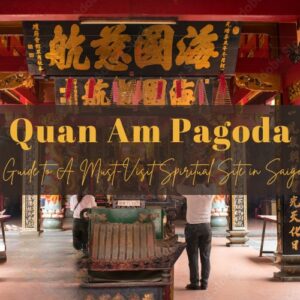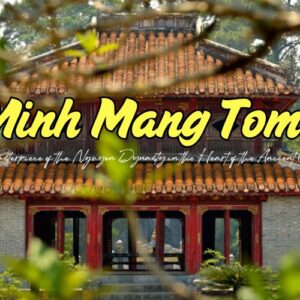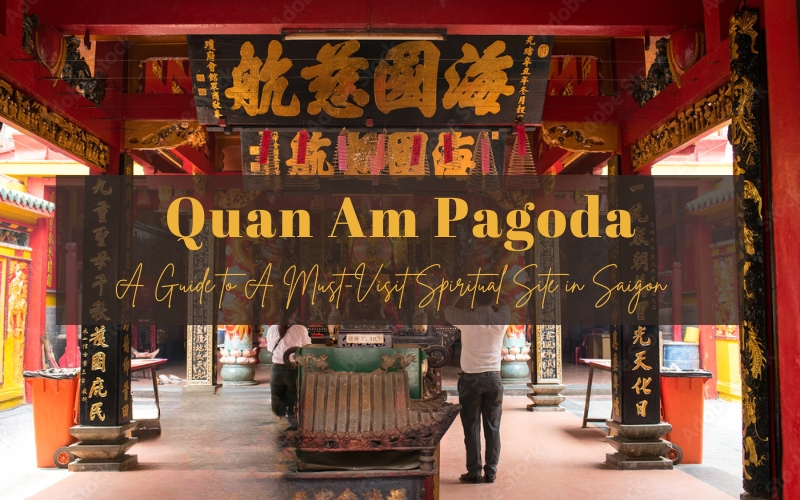
Quan Am Pagoda, or On Lang Assembly Hall, is an interesting spiritual tourist destination in Ho Chi Minh City. With its sacred space, unique architecture and special festivals, this is an ideal destination to learn about the beliefs and history of the Chinese community in Saigon. This article will help you discover this famous pagoda in the heart of Saigon.
General information about Quan Am Pagoda
- Address: 12 Lao Tu Street, Ward 11, District 5, Ho Chi Minh City
- Entrance fee: free
- Opening hours: 6 AM – 5 PM
Quan Am Pagoda in District 5 is an ancient and sacred pagoda of Vietnamese people of Chinese origin in Saigon, located on a small street but in the most prime location in Cho Lon area – or Ho Chi Minh’s Chinatown. The pagoda was built in the 18th century, originally known by another name, On Lang Pagoda or On Lang Assembly Hall, inside is the main shrine of Quan Am Bodhisattva, the great merciful Bodhisattva, along with many other gods according to Chinese folk beliefs. Quan Am Pagoda is one of the pagodas with important historical and cultural significance in Ho Chi Minh City. Although much smaller than the surrounding temples, it has a very cozy atmosphere with colorful designs.
In December 2002, the Ministry of Culture and Information recognized this place as a national architectural and artistic relic. With its unique architecture and long history, Quan Am Pagoda is considered one of the oldest pagodas of the Chinese community in Ho Chi Minh City. Quan Am Pagoda contributes to maintaining and promoting the unique cultural features of the Chinese people while becoming a place for community exchange and spiritual connection between generations. Not only is it a place of worship for local people and visitors, Quan Am Pagoda is also a place to organize cultural and religious activities such as the Mid-Autumn Festival, Lunar New Year Festival and Buddhist meditation courses.
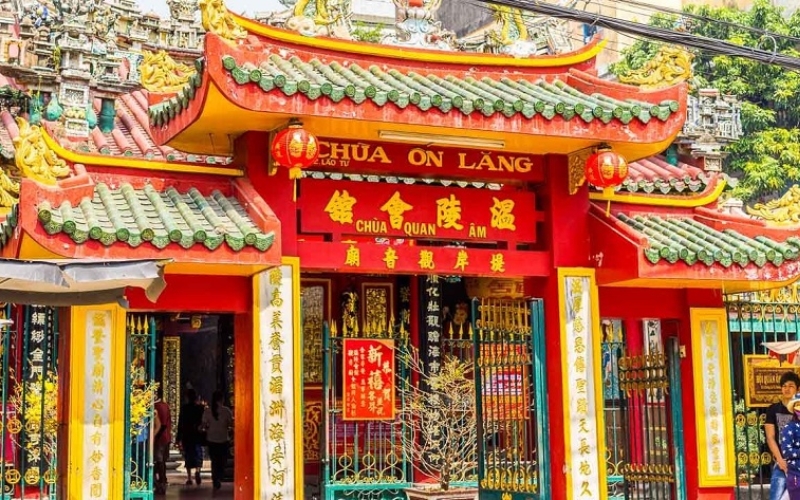
Quan Am Pagoda, or On Lang Assembly Hall
> > > To fully experience the rich culture and history of this bustling city, why not explore beyond Quan Am Pagoda with our Ho Chi Minh City tours? Discover the best tours that take you through the city’s iconic landmarks and hidden gems!
History of Quan Am Pagoda
Quan Am Pagoda is a valuable historical and cultural relic, witnessing the changes and developments of the Saigon – Gia Dinh area since the French colonial period. The pagoda was formerly the headquarters of the Chinese people from Tuyen Chau, Fujian (China) who migrated to Saigon – Cho Lon. They were wealthy and dynamic merchants, contributing to the prosperity of the Saigon – Cho Lon area. After gradually stabilizing, in 1740, this community decided to build Quan Am Pagoda, a place to worship Thien Hau Thanh Mau, the godess who protects fishermen and those who work far away.
Initially, the pagoda was called On Lang Assembly Hall, meaning warm and pleasant. Later, the Assembly Hall added a statue of Quan The Am Bodhisattva, the compassionate and suffering bodhisattva, so from then on, the Assembly Hall was called Quan Am Pagoda or Thien Hau Pagoda. After undergoing renovations in 1867, 1869, 1897, 1993 and 1995, the temple has been completed until now, becoming a place for communal activities, worshiping gods and preserving customs.
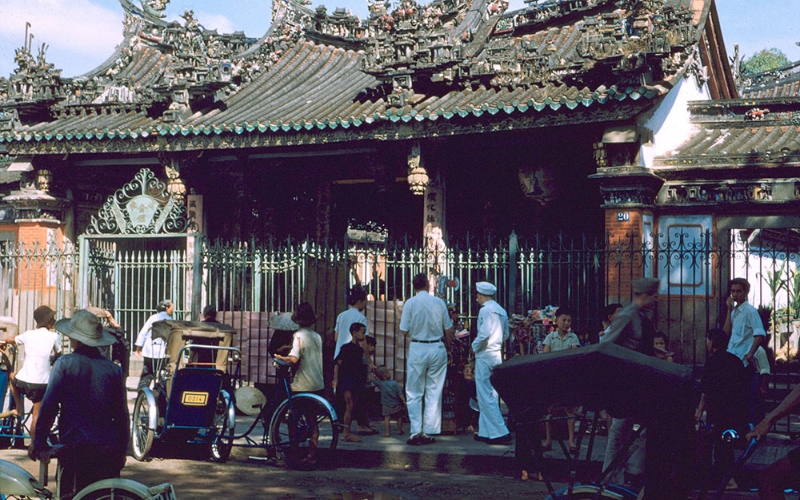
The pagoda in the French colonial period
Main attractions of Quan Am Pagoda
Distinctive Chinese-style architecture
Quan Am Pagoda not only has beautiful architecture but also has a pure and sacred atmosphere. The pagoda is surrounded by green trees and lotus ponds, creating a peaceful space in the heart of the bustling city. The pagoda has classical Chinese architecture with red tiled roofs, white wooden pillars, brick walls and many sophisticated decorative motifs. The pagoda has three main rooms: the front hall, the main hall and the back hall, which are places to worship gods according to Chinese folk beliefs. In addition, the pagoda also has a Ngu Hanh temple to worship Ngu Hanh Nuong Nuong and Chua Sinh Nuong Nuong, the god who specializes in helping with childbirth.
The highlight of the pagoda is the tiled roof style in each layer, the base of the roof is in the classical architectural style of the Fujian region with curved ridges and decorated with ceramic mascots such as unicorns and phoenixes. Each mascot attached to the ridge of Quan Am Pagoda has an extremely important and unique meaning.
In addition, the pagoda impresses with its unique front gate design. Above the main gate is an elaborately and delicately carved dragon image on both sides, creating a majestic and brave look for the temple. The harmonious combination of red, yellow and green colors makes the temple stand out among the modern high-rise buildings in District 5.
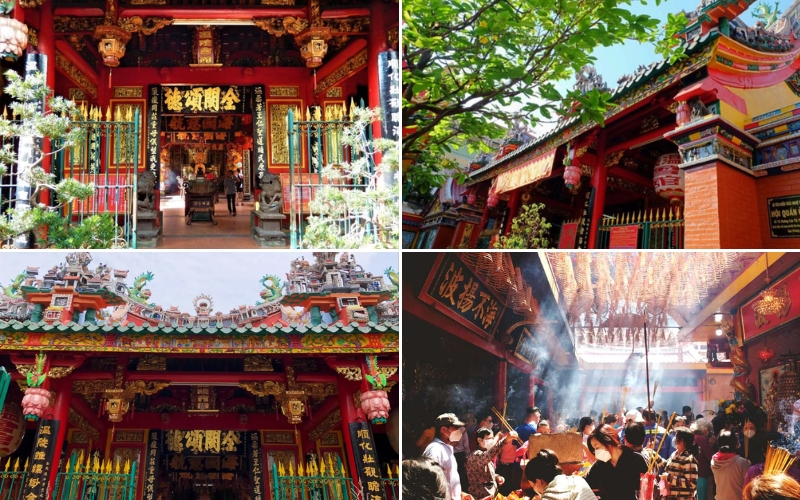
The sophisticated China-style architecture of Quan Am Pagoda
A lake for releasing animals in the heart of the city
In 1809, the Board of Directors of Quan Am Pagoda built a fish pond opposite to calm the pulse and gather energy, helping to create spiritual energy for the temple according to feng shui concepts. Located in the middle of the bustling Cho Lon area, the lake still brings fresh air, creating a peaceful atmosphere in the heart of the city. This is a place where visitors and locals can relax, enjoy the fresh air and immerse themselves in the peaceful space of the pagoda.
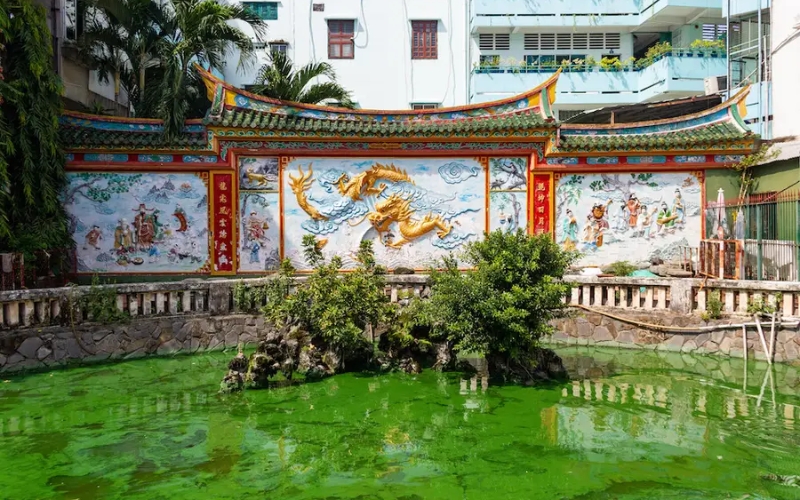
The small lake opposite Quan Am Pagoda
Unique rituals held in Quan Am Pagoda
Temple culture is associated with attractive worship customs. At Quan Am Pagoda, visitors will witness and participate in unique worship customs. A typical example is the custom of beating the villain, one of the activities that was once very famous among the Chinese, not only in Saigon but also all over the world. The villains will be paper figures, and people will use shoes or sandals to beat them continuously with the intention of driving away bad things and bad luck.
The custom of beating the villain at Quan Am Pagoda usually takes place on Kinh Trap day from March 5 to 6 in front of the Tiger altar. The altar will have tangerines and dumplings in even numbers with the words Phuoc and Dai Phat printed in red. In front of the altar, there is raw pork offered by the people as an offering. According to many people, this custom is now only commonly seen at Quan Am Pagoda. Therefore, this is also one of the activities that cannot be missed if you have the opportunity to visit this temple.
In addition to the extremely famous custom of beating the villain, the temple also has a very sacred love-praying ceremony. Young men and women who have difficulties in love come to the temple to offer prayers and will soon find the love they desire. Visitors who want to go to the temolel to pray for love need to prepare a red thread, with a needle already inserted on top, and then place it on the altar of Hoa Phan Phu Nhan.
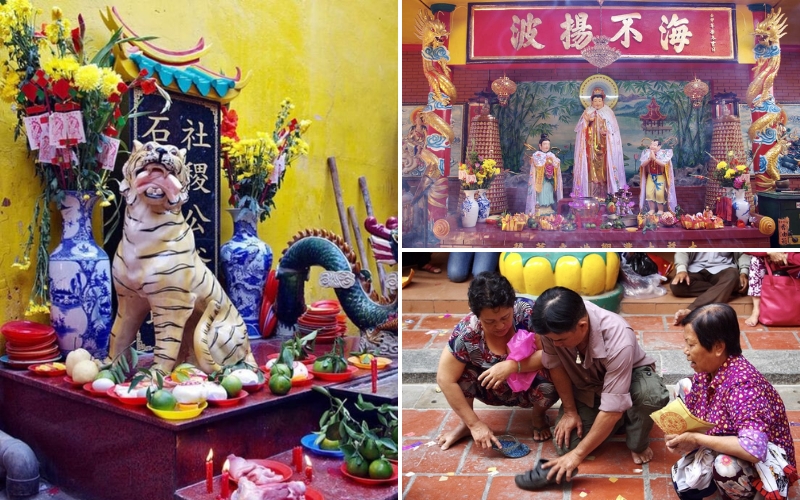
Some unique rituals held in Quan Am Pagoda
The temple worships many gods, but the main one is Bodhisattva Quan Am to pray for wealth, prosperity and health, and Thien Hau Thanh Mau, the goddess who protects those who work far away. This is also one of the main reasons that attracts visitors from afar and local people to visit Quan Am Temple all year round.
The biggest festivals here are Quan Am’s birthday ceremonies, in which the main festival is held on the 19th day of the 6th lunar month, and the secondary festivals take place on the 19th day of the 2nd lunar month and the 19th day of the 11th lunar month. On this day, crowds of people come to burn incense and pray for blessings on the holiday. Because according to the concept of the Cantonese Chinese, this is the occasion for Quan Am Bodhisattva to manifest and open the treasury, giving blessings to the people during times of crop failure and famine.
The gods worshiped in the pagoda
Quan Am Pagoda is famous for its worship of many gods, about 16 of them, according to Chinese beliefs, which were established by the local community.
- Front hall: A place to worship gods according to Chinese folk beliefs, including the Great Sage Equal to Heaven, Bao Gong, Emperor Wenchang, 18 Arhats, Mother Earth Goddess, Heavenly Father and Mother Goddess…
- Main hall: A place to worship Mother Heaven, the guardian deity of seafarers and women in childbirth. On both sides of the main hall are two small rooms, one worshiping Bodhisattva Guanyin, the other worshiping Buddha Amitabha.
- Back hall: A place to worship other gods such as Thai Bach Kim Tinh, Emperor Jade Emperor and Grand Tutor Tran Hung Dao.
- In addition, in the temple grounds there is also the Ngu Hanh Temple, a place to worship Ngu Hanh Nuong Nuong and Chua Sinh Nuong Nuong, the guardian deity of childbirth.
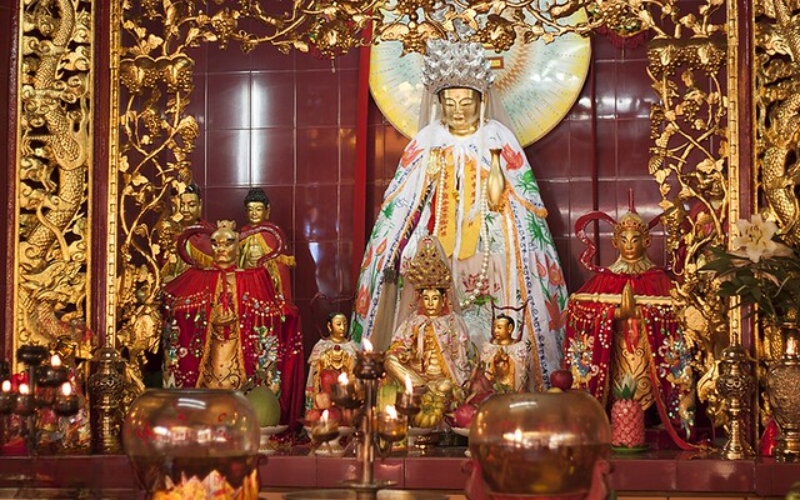
The place to worship Bodhisattva Guanyin
Tips for your first visit to Quan Am Pagoda
Below are some notes for visitors to Quan Am Pagoda to ensure your trip is complete:
- Visitors to visit the pagoda and make offerings should dress modestly and politely to show respect for the sacred place. Choose polite, modest clothing, not too short or revealing to maintain solemnity at the pagoda.
- Comply with the regulations set by On Lang Pagoda. When entering the main hall or other temples, do not forget to bow and ask for permission before entering. You should burn incense and pray according to the meaning of each deity. Absolutely do not touch the worship items or Buddha statues in the pagoda.
- Do not jostle or push each other when offering offerings to the altar. Do not litter in public places, be conscious of maintaining hygiene at the tourist destination.
- Pay attention to the opening and closing times of the temple to plan a suitable visit. In addition, check the weather before traveling to avoid affecting the schedule. There are also many other famous tourist attractions near the temple, you can combine your visit between the locations when coming to District 5.
- The temple does not charge an entrance fee, instead, you can donate money to support the temple.
- Visitors can visit the temple at any time of the day. The temple can become especially crowded during Buddhist holidays and during the Lunar New Year, but you will be able to observe and learn more about the culture of the Chinese community in Saigon.
After hundreds of years of existence, Quan Am Pagoda is not only a pagoda with unique architecture but also a relic containing many historical, cultural and religious meanings. If you travel to bustling Saigon, don’t forget to visit Quan Am Pagoda!
Read more:

